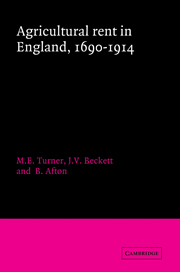Book contents
- Frontmatter
- Contents
- List of figures
- List of tables
- Preface
- Note on the text
- List of abbreviations
- Two examples of contemporary rent books
- Introduction
- 1 Agricultural rent in England
- 2 Contemporary views of rent in eighteenth and nineteenth-century England
- 3 The current state of knowledge
- 4 The determining parameters of a rent index
- 5 Constructing the rent index I: estate records
- 6 Constructing the rent index II: government inquiries
- 7 Constructing the rent index III: other studies
- 8 An English agricultural rent index, 1690–1914
- 9 Rent arrears and regional variations
- 10 The rent index and agricultural history I: the long term
- 11 The rent index and agricultural history II: the short term
- Conclusion
- Appendix 1 Sources of the rent index
- Appendix 2 Statistical summary
- Bibliography
- Index
5 - Constructing the rent index I: estate records
Published online by Cambridge University Press: 02 December 2009
- Frontmatter
- Contents
- List of figures
- List of tables
- Preface
- Note on the text
- List of abbreviations
- Two examples of contemporary rent books
- Introduction
- 1 Agricultural rent in England
- 2 Contemporary views of rent in eighteenth and nineteenth-century England
- 3 The current state of knowledge
- 4 The determining parameters of a rent index
- 5 Constructing the rent index I: estate records
- 6 Constructing the rent index II: government inquiries
- 7 Constructing the rent index III: other studies
- 8 An English agricultural rent index, 1690–1914
- 9 Rent arrears and regional variations
- 10 The rent index and agricultural history I: the long term
- 11 The rent index and agricultural history II: the short term
- Conclusion
- Appendix 1 Sources of the rent index
- Appendix 2 Statistical summary
- Bibliography
- Index
Summary
Having set out in chapter 4 the parameters within which we are working, we turn now to our methodology, and in particular to the way in which we selected estate records for inclusion in the database and then to the decisions we took about how and what data we should record.
We were fortunate in that we did not have to begin our study ‘cold’; indeed, we enjoyed the benefit of a pilot study conducted some years ago by J. R. Wordie. The study was designed to uncover archival material relating to the administration of landed estates between the seventeenth and nineteenth centuries. As a result, Wordie listed the availability of rental material in record repositories across the country which he believed could be used to construct an index of rack rents of agricultural land. In addition, we consulted a number of historians and historical geographers with specialist knowledge relating either to agricultural rents, or to related subjects. We requested, and were generously offered advice on our methods and suggestions regarding archival sources. Finally, archivists in Record Offices around the country were kind enough to point us in the direction of other sources which might prove useful. Our inquiries left us with a list of approximately 200 archives which merited further investigation. This generally involved visiting archive repositories to sample a selection of account books, rentals, and surveys of the estate records held in each, in order to ascertain whether or not the material was of sufficient quality to be included in our work.
- Type
- Chapter
- Information
- Agricultural Rent in England, 1690–1914 , pp. 85 - 106Publisher: Cambridge University PressPrint publication year: 1997



